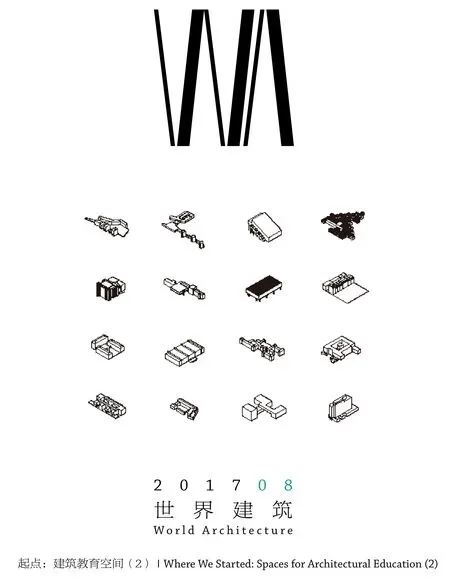改进建筑60秒
2018-01-03栏目主持叶扬
栏目主持:叶扬
改进建筑60秒
Sixty Second Idea to Improve Architecture
栏目主持:叶扬
我们仿效BBC的广播节目“60秒改进世界”(Sixty Second Idea to Improve the World)推出了“改进建筑60秒”栏目,每期将在世界范围内采访两位人物,请他们就建筑、城市、景观、技术等相关问题在60秒的时间里讲出一个或两个有启发性、批判性甚至有争议性的观点。本栏目如实记录了他们的话,采访所拍摄的视频将会出现在我们的相关网页上。所述观点只代表嘉宾本人,与本杂志立场无关。□

迈克尔·斯皮克斯
雪城大学建筑学院院长、教授
Michael Speaks
Dean and Professor, School of Architecture, Syracuse University

米凯利·博尼诺
都灵理工大学副教授
Michele Bonino
Associate Professor, Politecnico di Torino
Today Urbanization, Climate Change and Technological Disruption have combined to create an ever more volatile and unpredictable world.
It is a world with many challenges and if architects are to play a significant role in shaping this new world, they will have to turn their attention away from managing the PRESENT towards designing FUTURE, from the known to the unknown.
Architects must embrace the FUTURE and focus on what MIGHT BE not on WHAT IS. Architects must stop relying on the quantification of the present, on technology, to solve our problems, and instead embrace DESIGN, an entirely future oriented practice.
Design, whether manifest through a process of hand drawing or 3D animations, speculates through an iterative, prototype-driven process to pose and solve problems unanticipated by the present.
Technology focuses only on the present, only on existing problems that we provide. Design focuses instead on the future and speculates about what might be, and in the process, creates new things and adds new value unanticipated by technology.
Architects will become obsolete if they are content with the present, if they become slaves to technology.
If, on the other hand, architects once again embrace design, they will help to shape the present and transform it into the future.□
In my experience as a designer, I see that good buildings seldom are generated by aesthetic and formal approaches: they are destined to collide against different interests, against economic constraints, against the pragmatism of clients. They rarely come intact until the end of the design and the construction. I propose another approach, which seems more effective and closer to the needs of real processes: I call it "problem-solving architecture".
Even for the most rigorous architects, there is at least one moment that can not be entirely objective, a moment of intuition: it is usually the design concept, the first sketches, the conceptual diagrams. However, to avoid the risk of formal complacency, it is better to move this moment even earlier in the process. The real intuition is not how the problem is solved, but how it is formulated: here interpretation, creativity, invention can be centered. Sometimes the problem is explicit in the initial conditions of the project, in the client's requests, in the difficulties of the site or program. Other times the problem is not obvious, he asks to be clarified and interpreted. Even more rarely, it does not seem to be even present: then it is necessary to provoke it, to construct it in artificial and programmatic form. Once the problem has been formulated, the project can solve it with care and coherence. The final result is interesting because it materializes the problem and its solution, often unpredictably. If applied honestly, it can be a good approach: pragmatic, not opportunistic, by its nature far from formal heroisms.□ (Thanks to Subhash Mukerjee for sharing these ideas during our joint designs.)

建筑自然环境的复苏:空气,舒适,气候
The Recovery of Natural Environments in Architecture: Air, Comfort, Climate
作者:查尔斯·艾伦·肖特/C. Alan Short
出版:Routledge, 2017
Naturally responsive buildings enrich the history of vernacular architecture and show how peoples worldwide have dealt with all types of climate to ensure human comfort and health. There has been a danger that all this can get lost in the rapidly changing technological world. Alan Short is the ideal person to demonstrate how we can make "a recovery" which he demonstrates vividly in the many case studies he discusses in great detail throughout this book. Ideal because he is a research architect who has an innovative practice but also works with many leading universities via his home university at Cambridge. He is a highly cultured man who is well read in the arts, history and philosophy beyond his metier of architecture. As an example just take the first two pages of the last chapter 10 in which the names John Ruskin, M.Friedlander, Goethe, Alberti, Nietzsche, Huntington, Dr Reid, J.S Billings, Dr Pettenkofer are just a few that occur on these two pages and they span the areas of philosophy, art, architecture and ventilation. This book is a tour de force in holistic human thought in which the divisions between the arts, engineering and science dissolve before your very eyes. A lesson for education and the professional institutions lies here I think. But there is a real purpose too – to reconnect our architecture with the natural world for the benefit of people and not for this ideal to subsumed by the force of technology.
Each chapter terminates with fulsome notes which clarify issues but the author has a concentrated writing style so descriptions and explanations are already in great detail and beautifully illustrated in colour and often with accompanying drawings. There are some 290 illustrations throughout the 377 pages. This is a seductive presentation with works of art frequenting some chapters. All this stirs the imagination.
Needless to say the well-known buildings like the Queens Building at De Montfort University; the Malta Brewery; the Coventry Arts and Media Centre and many more feature. Extensive chapters concentrate on theatres and hospitals. Other chapters discuss and argue the various characteristics of the various climatic regions around the world that have driven the vernacular architecture we have and from which we can learn so much.□ (撰文 /Text: 克莱汀斯 ·柯纶 /D. J. Clements-Croome, 雷丁大学荣誉教授 /Professor Emeritus at Reading University)

建筑中的设计研究总览
Design Research in Architecture: An Overview
编者:莫里·弗雷泽/Murray Fraser
出版:Ashgate, 2013.

康斯坦丁·梅利尼科夫的建筑1920s-1930s
作者:Frits Bath
出版:Axel Menges, 2015
1990年代中期兴起的设计研究(research by design)正在全球范围从建筑院校的新思潮进入业界成为一种新的设计“文化”,激发新的工作形式和讨论议题。在这个新浪潮中,实践者开始通过设计教学、展览、工作坊和集群设计等形式,经由大众和建筑媒体,开展自己的设计探索。传统的理论与实践之间的范式在发生显著的变化。与这一以“研究性探索”和“反思性实验”为特征的热潮相对的,是研究与实验背后的理论讨论的缺乏。英国建筑理论家默里·弗雷泽(Murray Fraser)主编的文集《建筑学中的设计研究总览》(2013)为任何对设计研究感兴趣的建筑学生或建筑师提供了一个最好的入门读物。作为理论家,默里·弗雷泽曾长期担任顶级期刊《建筑学报》(Journal of Architecture)的主编,同时他也是一位设计研究的实践者,他作为主要人员参加的巴勒斯坦比尔泽特历史中心区复兴项目获得了2013年的阿卡汗建筑奖。这也体现了设计研究有别于传统理论研究之处——它强调在实践中思考,制图、模型、图解、文本分析乃至建造干预都构成实践与反思的常见工具。在这个循环过程中至关重要的是思维方式和工作方法,这些恰恰是本书的关注点。本书由12篇论文组成,作者包括了来自墨尔本皇家理工大学的理查德·布莱恩(Richard Blythe)和莱昂·斯海克(Leon van Schaik)、爱丁堡大学的理查德·科因(Richard Coyne)、UCL的乔纳森·希尔(Jonathan Hill)、加州大学圣迭戈分校的迪特·克鲁斯(Teddy Cruz)等一批重要的设计研究学者。此外本书结尾提供了设计研究的125本参考书目。□ (撰文:鲁安东,南京大学建筑与城市规划学院教授)
这本画册是2002年10月19日-12月21日,在东京的建筑画廊GALLERY.MA举办的康斯坦丁·梅利尼科夫(Konstantin Melnikov)建筑展的展览图录,这是日本首次举办全面介绍康斯坦丁·梅利尼科夫建筑的展览,画廊虽不大,但是展览的影响是持久的。
梅利尼科夫在建筑上的独创性,使得他在20世纪的建筑史上,特别是在俄罗斯先锋派建筑史上享有特别的位置。至今我们还是可以在莫斯科市内找到许多他的建筑手笔。除此之外,他留下了大量未完成的方案草图,对后世继续产生影响,可是在中国还没有一本关于他的著作。
这本画册主要介绍了他在1920-1930年代之间的作品,也是前苏联建筑、艺术和城市建设黄金时代的成就。在众多的建筑师中,为什么梅利尼科夫独树一帜,就是他的代表性建筑设计,是社会主义革命之后,对原有时代的建筑法则进行了彻底的颠覆,他所创造的样式和概念是时代的最先端。他的设计灵感如泉涌,他并没有将这些手法系统化,而是不断尝试新的手法。梅利尼科夫所信奉的理念是,建筑体现了艺术的最高形态,而艺术是创造的源泉。他讨厌在自己的设计中反复使用相同的元素,这也是他之所以能不断推陈出新的缘由,从而也是他创造新样式所信奉的信条。
梅利尼科夫在很长一段时间里被冷落,他作为建筑师重返舞台是1965年他75岁的时候举办了个人大型展览之后,他所获得的评价是俄罗斯伟大的建筑师,而他的影响早已在俄罗斯之外,他自己设计的自宅已经是建筑学校授课的建筑模型范本。□(撰文:方振宁,独立策展人,评论家)

在建筑中发现梦想
作者:安藤忠雄
出版:中信出版社, 2014译者:许晴舒
安藤忠雄是我所知道的最热爱建筑的建筑师,而且是很特别的建筑师。原因在于他成为建筑师之前没有受过正规系统的建筑教育。
《在建筑中发现梦想》这本书几乎是安藤忠雄重要建筑人生的告白与回顾。亲切自然的文字语言叙述,仿佛与读者像老朋友一样交谈。因此读起来很亲切,轻松,并被深深地感染,以至于真情难忘。安藤忠雄把建筑称为人们的“梦想”,这种“梦想”深深感动了安藤,使得他喜欢了建筑,并希望成为实现人们“梦想”的建筑师。
他开始思考居住的含义,城市公共空间的意义,建筑创作与环境的对话,建筑的保护与重生,建筑材料与技术对建筑的重要作用。建筑的教育与建筑运动,建筑与地域文化、人文情感的关联。他提出了城市、建筑、设计原点的主张(公共空间 、居住、设计者)。他把思考与理念,恰如其分地应用到城市、建筑(甚至田园、乡野)的创作的实践中。为了人们美好的梦想,安藤在每一个建筑设计之前,总是非常认真地调研,然后思考、总结归纳,投入巨大的精力与热情,努力寻找最贴切解决城市、建筑空间的方法。运用建筑材料与技术的特性,表达建筑梦想迷人的质感与张力。
《在建筑中发现梦想》这本书值得一读,从中我们可以看到建筑师的建筑观,建筑师的精神,如何成为建筑师,如何成为令人称颂的建筑师,如何理解建筑师创造的梦想。□(蒋培铭,北京培铭建筑设计咨询有限公司总建筑师)
